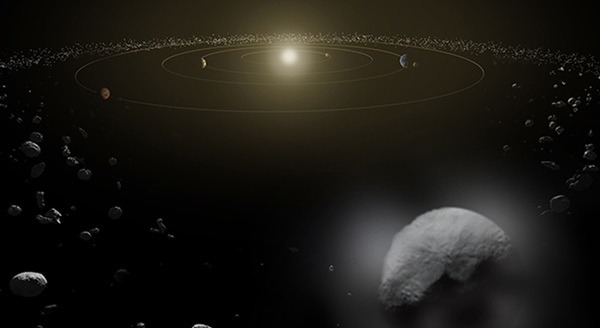Key Takeaways:
“We know so little about our vast solar system, but thanks to economical missions like Dawn, those mysteries are being solved,” said Jim Green from NASA Headquarters in Washington, D.C.
At 43 pixels wide, the new images are more than 30 percent higher in resolution than those taken by NASA’s Hubble Space Telescope in 2003 and 2004 at a distance of over 150 million miles (241 million km). The resolution is higher because Dawn is traveling through the solar system to Ceres, while Hubble remains fixed in Earth orbit. The new Dawn images come on the heels of initial navigation images taken January 13 that reveal a white spot on the dwarf planet and the suggestion of craters. Hubble images also had glimpsed a white spot on the dwarf planet, but its nature is still unknown.
As the spacecraft gets closer to Ceres, its camera will return even better images. On March 6, Dawn will enter into orbit around Ceres to capture detailed images and measure variations in light reflected from Ceres, which should reveal the planet’s surface composition.
“We are already seeing areas and details on Ceres popping out that had not been seen before. For instance, there are several dark features in the southern hemisphere that might be craters within a region that is darker overall,” said Carol Raymond from JPL. “Data from this mission will revolutionize our understanding of this unique body. Ceres is showing us tantalizing features that are whetting our appetite for the detailed exploration to come.”
Ceres, the largest body between Mars and Jupiter in the main asteroid belt, has a diameter of about 590 miles (950km). Some scientists believe the dwarf planet harbored a subsurface ocean in the past and liquid water may still be lurking under its icy mantle.
Originally described as a planet, Ceres was later categorized as an asteroid, and then reclassified as a dwarf planet in 2006. The mysterious world was discovered in 1801 by astronomer Giuseppe Piazzi, who named the object for the Roman goddess of agriculture, grain crops, fertility, and motherly relationships.
“You may not realize that the word ‘cereal’ comes from the name Ceres. Perhaps you already connected with the dwarf planet at breakfast today,” said JPL’s Marc Rayman.
Powered by a uniquely capable ion propulsion system, Dawn also orbited and explored Vesta, the second most massive body in the asteroid belt. From 2011 to 2012, Dawn returned more than 30,000 images, 18 million light measurements, and other scientific data about the impressive large asteroid. Vesta has a diameter of about 326 miles (525km).
“With the help of Dawn and other missions, we are continually adding to our understanding of how the solar system began and how the planets were formed,” said Chris Russell from the University of California, Los Angeles.










